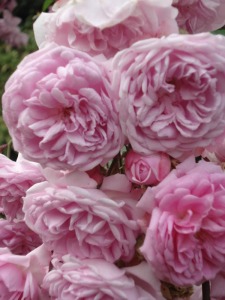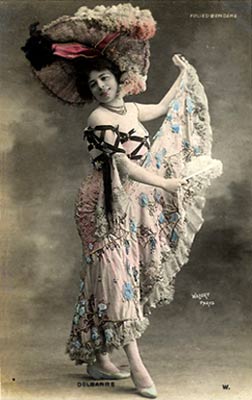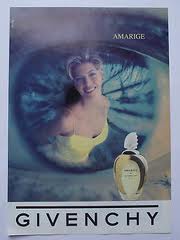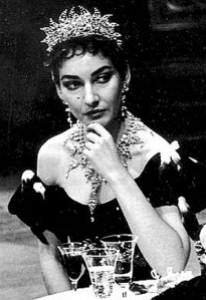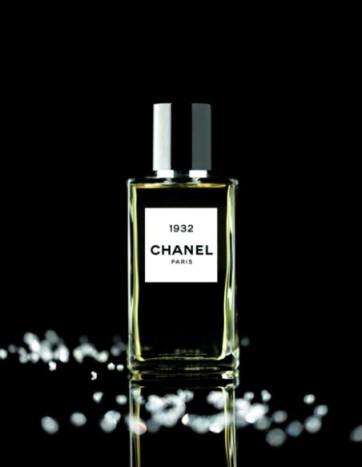In time for Valentine’s Day, Serge Lutens is releasing the first of two new fragrances for 2013. It is La Fille de Berlin (“The Girl from Berlin”), a unisex rose perfume that tries to pay homage to a woman’s strength, resilience and beauty in the face of destruction.
Lutens is a very intellectual perfumer who seeks to render concrete the most abstract of theories and images. That is never more evident than in his press materials for La Fille de Berlin — such as his explanatory video which you can watch below and which has been translated in full on YouTube.
A shorter, barely less oblique explanation of the scent is available in the press release posted on Fragrantica where Mr. Lutens describes the perfume as follows:
A flower grown under our ruins, cut off from the world, appears before your eyes to all of us to open our eyes. I took courage in both hands in her flowing Rheingold hair. On the lips, I tasted blood. My girl from Berlin showed combative, more beautiful than ever–and so I broke my contempt and yet my shame, hiding under the guise of my pride. Through the power of criticism, of love and hate, God and the devil, death and life, I drew a furrow in which she disappeared. And while the maelstrom together beats on me, I pay homage to her beauty enraged.

A scene from “A Woman in Berlin” (“Anonyma: Eine Frau in Berlin”.) REUTERS/Constantin Film/Handout. Source: Reuters article 2008
If all this esoterica leaves you sighing, you’re not alone. Long story short, La Fille de Berlin is meant to pay homage to the strength of German women who survived the Soviet occupation after the war — though there seems to be something much darker, more ominous, and much more violent being referenced in both his video comments and in the press release references above to shame and blood. If you read the complete YouTube quote from Mr. Lutens, you will get a full sense of the incredible bleakness, anger, betrayal and misery which seems to be at the start of his dark, almost existentialist mythology for La Fille de Berlin. (One almost wonders if he’s talking about rape, in addition to some sort of actual or symbolic “murder.” No matter how much resilience may be his ultimate theme, the whole thing is very unsettling.)
Since none of these things are a happy way to sell perfume (especially on Valentine’s Day), Mr. Lutens tries to be slightly more positive in his quotes to The New York Times where he states, “Beauty is the moment in which you rise up […] It is the moment when you pick up your head, stride through your own ruins and climb up the mountain.” Okay, it’s still not particularly happy and cheerful, what with “your own ruins” — but, at least he tried.
 There are no perfume notes for La Fille de Berlin. Lutens is a perfume house which often omits a large part of the ingredients in its perfume description but, here, it does so completely. The rumour mill says that La Fille is a rose and pepper scent, while Luckyscent feels some of the notes are “Rose, violet, pink and black pepper, musk” — but Lutens himself has stayed silent. On his website, the fragrance is only described with still further (and, by now, rather exasperating) lyricism:
There are no perfume notes for La Fille de Berlin. Lutens is a perfume house which often omits a large part of the ingredients in its perfume description but, here, it does so completely. The rumour mill says that La Fille is a rose and pepper scent, while Luckyscent feels some of the notes are “Rose, violet, pink and black pepper, musk” — but Lutens himself has stayed silent. On his website, the fragrance is only described with still further (and, by now, rather exasperating) lyricism:
She’s a rose with thorns, don’t mess with her. She’s a girl who goes to extremes.
When she can, she soothes; and when she wants … !
Her fragrance lifts you higher, she rocks and shocks.
That’s all well and good, but I’m afraid I find nothing shocking or extreme about La Fille de Berlin. It’s a lovely rose scent which starts with peony-like roses before taking a fruity (and almost fruity-patchouli) turn, then becoming rather austere and, by the end, quite nondescript. I found it pretty average as a whole, and far preferred Lutens‘ Sa Majesté La Rose for a rose scent — and any number of other Lutens fragrances in general. If truth be told, La Fille de Berlin was actually a bit of a disappointment. I’m not alone in feeling that way. One of the handful of reviews already out is from Cosmetopica (who also couldn’t make head nor tails out of Lutens’ lyricism). She, too, found the perfume far less distinctive and exciting than many of Lutens’ other creations.
La Fille de Berlin opens on me with a wet, dewy rose note that is faintly similar to the sweetness in a tea rose, but slightly richer and redder. That said, it’s not as rich as a hearty, beefy Bourbon or Damask rose, but something in-between. Perhaps, large peony roses? Soft violet notes flicker and dance at the edges. Sometimes, the scent seems soft and slightly powdered. At other times, heartier and deeper. The violet notes vaguely evoke YSL‘s Paris in its original formulation but Paris is a much warmer, headier, more intense, and spicier take on roses.
As some others have noted, there is a subtle green note which is present. It’s as if Christopher Sheldrake (Lutens’ favorite perfumer and traditional cohort in olfactory adventures) sought to bring in the scent of the green, leafy sepals which protect a rose bud. The green notes are hard to describe. They’re not like those at the start of Sa Majesté La Rose which is a much more lavish, baroque and dramatic scent after its green, slightly soapy start. In La Fille de Berlin, the green elements are fresher and slightly dewy, and underscored by what seems to be geranium leaf.
There is also an unexpectedly woody element, like that of a rose’s own stem, and elements of rich, wet soil. It’s an odd mix — greenness with earthy, loamy soil and the faintly woody aspect of a rose stem — and it makes me wonder if Christopher Sheldrake sought to disassemble every part of a rose before putting them back together again. He’s done that deconstruction trick for Lutens before; it was handled brilliantly with the tuberose flower in Tubereuse Criminelle.
Ten minutes in, La Fille de Berlin begins to take on a fruity aspect. At first, it’s the unexpected scent of cherries. Then, it’s just a general fruity smell under the veneer of sweetness and it strongly resembles some purple patchouli fragrances I smelled last year. Specifically, it calls to mind Marc Jacobs‘ Lola and, to a much lesser extent, Chanel‘s Coco Noir. Both are scents with rose, a fruity patchouli element, notes of pear, pink peppercorn, and geranium, over a base of musk. As the Fragrantica notes demonstrate, Lola, in particular, is a primarily rose and peppercorn perfume with fruity-patchouli overtones. I own Lola and Coco Noir, so I sprayed on a little bit of each on my legs to see if I was just imagining things.
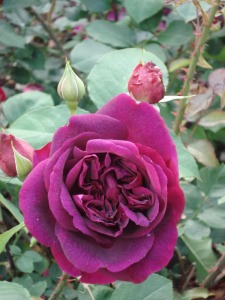
Purple rose at Warwick Castle, England. Photo provided with permission by CC from “Slightly Out of Sync” blog.
I was not imagining things. Though Lola opens with heavy fruit notes, it soon develops into something extremely similar to the jammy, peppercorn rose in La Fille de Berlin. Coco Noir is completely different in its opening, but it too has that jammy, purple, fruity patchouli element in its middle stages. (I reviewed it here, if you’re interested.) It should be noted that Christopher Sheldrake (who undoubtedly created La Fille de Berlin) was also responsible for Coco Noir, along with Chanel’s in-house perfumer, Jacques Polge. But it is really to Lola that La Fille de Berlin seems most similar at the start. The main differences is that the latter is slightly less fruity, much more subtle and fresh, and of infinitely better quality. There is nary a screeching synthetic in sight — which is much more than I can say for Mr. Jacobs’ creation.
Two hours in, La Fille de Berlin changes. The sillage drops even further, and the perfume takes on a cold, austere, almost metallic bent. It loses what warmth it had and becomes a linear progression that is predominantly rose with white musk and light sandalwood. It is far from exciting. Victoria from Bois de Jasmin had a far sexier time with the scent, experiencing amber, musk and faintly “naughty” bits:
A couple of hours later, my skin smells of amber and musk. La Fille de Berlin has an intriguing animalic note that would be untoward and raunchy if the rest of the composition were not so refined and polished. The reference here seems to be Serge Lutens’s own Muscs Koublaï Khan […] a rose wrapped into so much musk and civet that it becomes something else altogether. La Fille de Berlin, on the other hand, is much less musk and more rose, and it’s well-behaved enough to be worn to the office without raising anyone’s alarm. But when you press your wrist to your nose, you notice the naughty and smoldering bits. The impressive tenacity will ensure that you will be aware of La Fille de Berlin for the entire day.
I only wish I had her experience; it sounds infinitely more interesting! Having just tested extreme animalic musk and naughtiness in Parfum d’Empire’s Musc Tonkin, I’d be quite alert to the presence of any skanky notes or civet in La Fille de Berlin, no matter how minute and refined. But, alas, I simply don’t smell it here. No amber, either. There is some earthiness which was there from the start, though faint, but I attribute it to the undertones of what seemed more like patchouli than animalic elements. And, even so, on a scale of 1 to 10 (with 10 being extreme earthiness), I’d place the note at a 3.5 at the start and at a mere 1 towards the end. Instead, something else is much more evident. I swear, even in the dry-down, there is a fruity note! It is much, much more subtle than it was at the start, but it is still there. I find it excessively sweet, and I blame it on the pepper which has to be closer to the fruitier type of pink peppercorn berries than to anything black and biting.
As a whole, my experience with the final hours was much closer, again, to that of Cosmetopica. She owns and loves Muscs Koublai Khan, so she would have noticed any animalic similarities had she encountered them. Instead, she detected milky sandalwood in the dry-down. I agree; I found a definite creamy, soft, milky aspect to things, though to my nose it didn’t smell like strong or, even, genuine sandalwood. More like an ersatz cousin, if you will. For the most part, it was mild and quite overwhelmed by the white musk and by that endless fruity element.
La Fille de Berlin had average sillage and very good longevity. The perfume projected for the first twenty minutes before settling in to become much more discreet. It became close to the skin about three hours in, though it was still strongly noticeable if you brought your wrist to your nose. The overall duration of the scent was a little under nine hours on me. On Cosmetopica, it was eight; on Victoria from Bois de Jasmin, “the whole day.”
All in all, La Fille de Berlin is well-behaved, refined, unisex perfume that is perfectly pleasant — with all the implications that accompany that last adjective. As Cosmetopica’s review noted, one buys niche perfumes with their higher price tag for something that is slightly more distinctive and interesting. Serge Lutens has perfumes that run the gamut from being intellectually brilliant masterpieces that are not versatile scents for everyday use, to things that are simply lovely and constantly wearable, to scents that are occasionally just perfectly “nice.”
This is the latter. Though the bright pink colour of the liquid is absolutely gorgeous and though I wanted to love it, at the end of the day, I found La Fille de Berlin to be quite boring. And, for reasons I can’t quite pinpoint, it wasn’t a particularly happy scent in my mind either, unlike Sa Majesté La Rose. (That conclusion doesn’t even consider Mr. Lutens’ incredibly dark and depressing backstory for the perfume which, ideally, I shall forget about as soon as possible.) However, as with every review, perfume is a wholly subjective thing — so what may not be my cup of tea may be a ravishingly sophisticated, discreet rose scent for others. As always, it’s best to try it and see for yourself.

